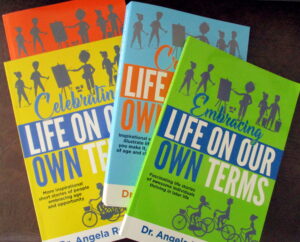We all get the collywobbles when we put our creative work out there into the wider world. In the lead up to a book launch event, it’s common for authors to question one’s own ability. When the event actually takes place, it’s evident that our stories really do matter – they matter to us, and they matter to our whanau and friends. For many, the compilation of stories in Memories of the Royal Family A Kiwi Collection is even more special as it contributes to our community’s social heritage and illustrates the diversity within our population.
I was thrilled with the turn-out at the community book launch event as family members, friends, neighbours, councillors and staff from the Kāpiti Coast District Council, fellow writers, and book enthusiasts gathered to meet the contributors, connect with one another, and generally join in the fun over morning tea. The buzz in the room was a testament to the power of storytelling, and the strength of our community. It was clear that this collection of stories holds a special place in the hearts of many and generated lively discussion at the tables. It was inspiring to see the outpouring of support from the community, especially when our Mayor Janet Holborow led the impromptu rendition of ‘God Save the King’. It was a reminder than when we come together as a community we can achieve incredible things.
The journey from concept to publication of this book has been a labour of love. Seeing this collection of stories in the hands of the contributors, and other readers was a dream come true. It is a reminder that every story matters, and that our voices have the power to inspire, educate and unite us. A couple of people remarked that this publication, which includes intimate family photos and original newspaper cuttings lovingly preserved in scrapbooks by our community, was collector’s item!


Reflecting on the event I am filled with gratitude for everyone who played a part in making it a success and loved the way in which people got into the spirit of the celebration and dressed up for the occasion. So many people have been involved in addition to the contributors who shared their personal stories. Kāpiti Coast District Council, who administer the local Creative Communities Fund, awarded the grant that contributed to the cost of the design and print of the book for the people that feature in it. Numerous individuals shared their Royal Family memorabilia on the display table at the event for others to enjoy. Family and friends helped me to organise, cater and bring the celebratory event to life, and of course there were people who remained behind afterwards and helped to clean up. Whether it was spreading the word, lending a helping hand, or simply showing up with enthusiasm, the community support made all the difference 😊


Looking ahead, I’m excited to see where this Kiwi collection of stories takes us. Whether it’s sparking meaningful conversations, inspiring others to share their own stories, or fostering community connection and engagement, we know the impact will be far-reaching. Huge thanks go to everyone who have been part of this incredible journey. Ngā mihi nui.
In the coming weeks and months, we’re committed to creating opportunities for our community to engage with the book and with each other in meaningful ways. This will include author talks for libraries, book clubs, service clubs, and community events in various locations in New Zealand. We’ll also continue to offer the popular series of Write Your Story community workshops for men and women who are inspired to capture their own memories for their families and friends.
Copies of Memories of the Royal Family A Kiwi Collection are available from your favourite bookstores in paperback, kindle and e.book formats. Copies can also be purchased directly from the author and at in person events. For more information email Kiaora@angelarobertson.nz










